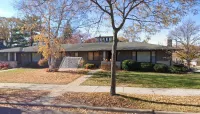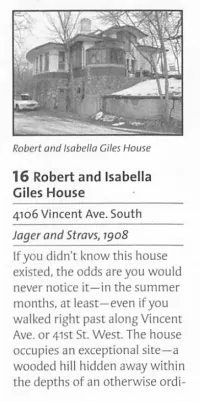Share what you know,
and discover more.
Share what you know,
and discover more.
Jan 01, 2009

-

- Charmaine Bantugan
4106 Vincent Ave S, Minneapolis, MN, USA
4106 Vincent Ave S Home History Jager and Stravs, 1908 If you didn't know this house existed, the odds are you would never notice it-in the summer months, at least-even if you walked right past along Vincent Ave. or 41st St. West. The house occupies an exceptional site-a wooded hill hidden away within the depths of an otherwise ordinary residential block-and it does nothing to advertise its presence. Its architects, John Jager and Carl Stravs, were born in the Austro-Hungarian Empire and were trained by leaders of the Viennese Secessionist movement, an early fork along the road to modernism. They were also influenced by the Prairie School work of Frank Lloyd Wright and his followers. This house has something of a Prairie look, but its curving eaves, blue brick accents, and exotic Art Nouveau details make it a one-of-a- kind production. It was built for Robert Tait Giles, an artist who founded his own stained-glass company in Minneapolis, and his wife, Isabella. The couple eventually moved to Chicago, where some of Giles's best work can be found. Citation: Millett, Larry. AIA Guide to the Minneapolis Lake District. Minnesota Historical Society Press, 2009.
4106 Vincent Ave S, Minneapolis, MN, USA
4106 Vincent Ave S Home History Jager and Stravs, 1908 If you didn't know this house existed, the odds are you would never notice it-in the summer months, at least-even if you walked right past along Vincent Ave. or 41st St. West. The house occupies an exceptional site-a wooded hill hidden away within the depths of an otherwise ordinary residential block-and it does nothing to advertise its presence. Its architects, John Jager and Carl Stravs, were born in the Austro-Hungarian Empire and were trained by leaders of the Viennese Secessionist movement, an early fork along the road to modernism. They were also influenced by the Prairie School work of Frank Lloyd Wright and his followers. This house has something of a Prairie look, but its curving eaves, blue brick accents, and exotic Art Nouveau details make it a one-of-a- kind production. It was built for Robert Tait Giles, an artist who founded his own stained-glass company in Minneapolis, and his wife, Isabella. The couple eventually moved to Chicago, where some of Giles's best work can be found. Citation: Millett, Larry. AIA Guide to the Minneapolis Lake District. Minnesota Historical Society Press, 2009.
Jan 01, 2009
4106 Vincent Ave S, Minneapolis, MN, USA
4106 Vincent Ave S Home HistoryJager and Stravs, 1908
If you didn't know this house existed, the odds are you would never notice it-in the summer months, at least-even if you walked right past along Vincent Ave. or 41st St. West. The house occupies an exceptional site-a wooded hill hidden away within the depths of an otherwise ordinary residential block-and it does nothing to advertise its presence. Its architects, John Jager and Carl Stravs, were born in the Austro-Hungarian Empire and were trained by leaders of the Viennese Secessionist movement, an early fork along the road to modernism. They were also influenced by the Prairie School work of Frank Lloyd Wright and his followers. This house has something of a Prairie look, but its curving eaves, blue brick accents, and exotic Art Nouveau details make it a one-of-a- kind production. It was built for Robert Tait Giles, an artist who founded his own stained-glass company in Minneapolis, and his wife, Isabella. The couple eventually moved to Chicago, where some of Giles's best work can be found.
Citation: Millett, Larry. AIA Guide to the Minneapolis Lake District. Minnesota Historical Society Press, 2009.
Posted Date
Oct 05, 2023
Historical Record Date
Jan 01, 2009
Source Name
AIA Guide to the Minneapolis Lake District
Delete Story
Are you sure you want to delete this story?












